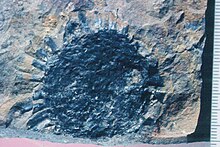Tomiostrobus
| Tomiostrobus Temporal range:
| |
|---|---|

| |
| Fertile plant of Tomiostrobus australis from Early Triassic Gosford Formation near Terrigal, NSW, Australia.[1] | |
| Scientific classification | |
| Kingdom: | Plantae |
| Clade: | Tracheophytes |
| Clade: | Lycophytes |
| Class: | Lycopodiopsida |
| Order: | Isoetales |
| Family: | Isoetaceae |
| Genus: | †Tomiostrobus Retallack |
| Species | |
Tomiostrobus is an extinct quillwort genus from the Early Triassic of Australia, China and Russia, which was especially widespread in the aftermath of
Permian Triassic mass extinctions.[2]



Description
Tomiostrobus australis is preserved as whole plants closely spaced within bedding planes, and lived as an early successional weed in lake and pond sedimentary environments, like living therapsids.[1]
See also
- Evolution of plants
References
- ^ .
- .
